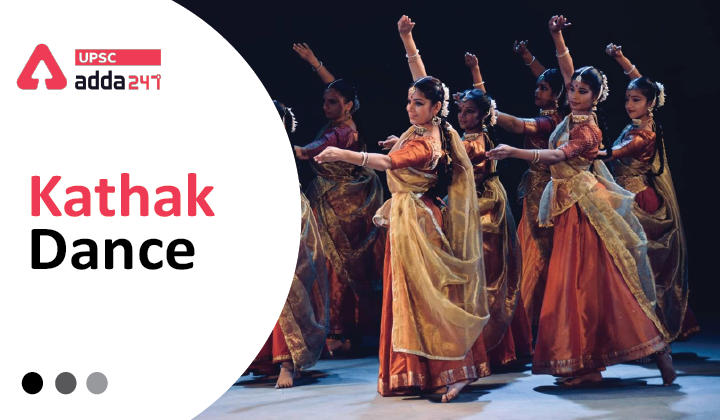Table of Contents
Kathak Dance- Relevance for UPSC Exam
- GS Paper 1: Indian History- Indian culture will cover the salient aspects of Art Forms, Literature and Architecture from ancient to modern times.

Kathak Dance- Context
- The Prime Minister expressed deep grief over the passing away of legendary Kathak dancer Pandit Birju Maharaj. He also said that his passing is an irreparable loss to the entire art world.
Kathak Dance- About
- Kathak Dance is one of the important classical dances of India. Kathak dance is said to have been started by Kathakars.
- Kathakars or storytellers are people who narrate stories largely based on episodes from the epics, myths and legends.
- Lady Leela Sokhey (Menaka) revived the classical style. Some prominent dancers include Birju Maharaj, Sitara Devi.
Kathak Dance- Background
- Kathak Dance probably started as an oral tradition. Mime and gestures were perhaps added later on to make the recitation more effective.
- Thus evolved a simple form of expressional dance, providing the origins of what later developed into Kathak as we see it today.
Kathak Dance- Evolution of Kathak
- Bhakti Movement: The Vaishnavite cult which swept North India in the 15th century and the resultant bhakti movement contributed to a whole new range of lyrics and musical forms, promoting Kathak.
- The Radha-Krishna theme proved immensely popular along with the works of Mirabai, Surdas, Nandadas and Krishnadas.
- Mughal Influence: With the coming of the Mughals, this dance form received a new impetus.
- A transition from the temple courtyard to the palace durbar took place which necessitated changes in presentation.
- In both Hindu and Muslim courts, Kathak became highly stylized and came to be regarded as a sophisticated form of entertainment.
- Emergence of Raslila: It was mainly developed in the Braj region (Mathura in Western U.P.). It combined in itself music, dance and the narrative.
- Patronage of Wajid Ali Shah: The nineteenth century saw the golden age of Kathak under the patronage of Wajid Ali Shah, the last Nawab of Oudh.
- He established the Lucknow Gharana of Kathak Dance with its strong accent on bhava, the expression of moods and emotions.
- The Jaipur Gharana is known for its layakari or rhythmic virtuosity and the Benaras Gharana are other prominent schools of Kathak dance.
Kathak Dance- Dance Movements
- The weight of the body is equally distributed along the horizontal and vertical axis.
- The full foot contact is of prime importance where only the toe or the ball of the foot are used, their function is limited.
- There are no deflections and no use of sharp bends or curves of the upper or lower part of the body.
- Torso movements emerge from the change of the shoulder line rather than through the manipulations of the backbone or upper chest and lower waist muscles.
- In the basic stance, the dancer stands straight, holds one hand at a level higher than the head and the other is extended out on the level of the shoulder.
- The technique is built by the use of an intricate system of footwork.
- Pure dance (nritta) is all-important where complex rhythmic patterns are created through the use of the flat feet and the control of the sound of the ankle bells worn by the dancer.
Kathak Dance- Key Features
- As in Bharatnatyam, Odissi and Manipuri, Kathak also builds its pure dance sequences by combining units of movement.
- The cadences are called differently by the names tukra, tora, and parana, all indicative of the nature of rhythmic patterns used and the percussion instrument accompanying the dance.
- The dancer commences with a sequence called That where soft gliding movements of the neck, eyebrows and wrists, are introduced.
- This is followed by a conventional formal entry known as the Amad (entry) and the Salami (salutation).
Bharatanatyam- Indian Classical Dance



 TSPSC Group 1 Question Paper 2024, Downl...
TSPSC Group 1 Question Paper 2024, Downl...
 TSPSC Group 1 Answer key 2024 Out, Downl...
TSPSC Group 1 Answer key 2024 Out, Downl...
 UPSC Prelims 2024 Question Paper, Downlo...
UPSC Prelims 2024 Question Paper, Downlo...




